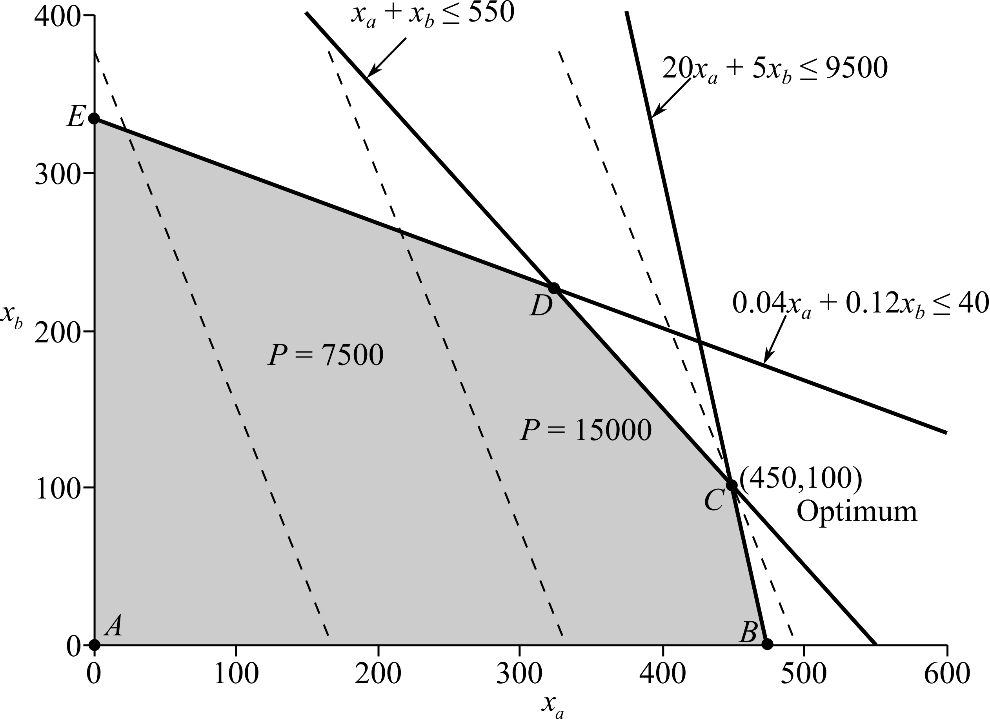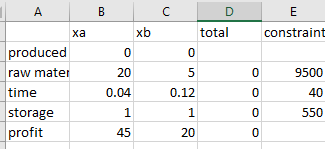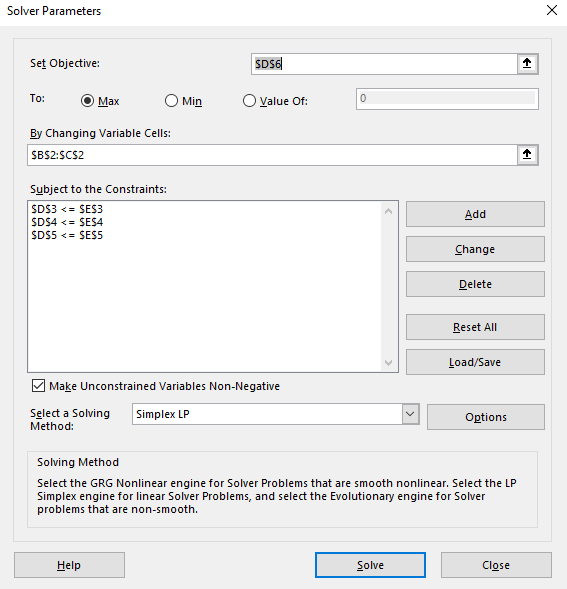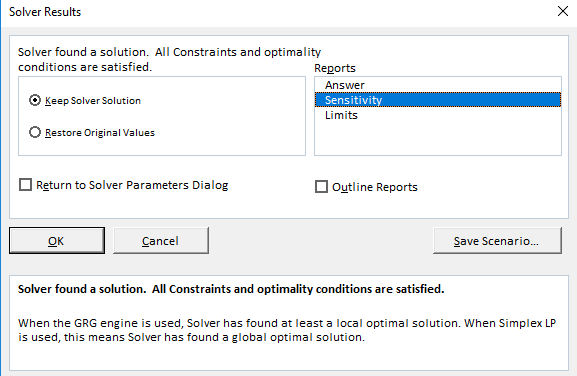
A company makes two types of products, A and B. These products are produced during a 40-hr work week and then shipped out at the end of the week. They require 20 and 5 kg of raw material per kg of product, respectively, and the company has access to 9500 kg of raw material per week. Only one product can be created at a time with production times for each of 0.04 and 0.12 hr, respectively. The plant can only store 550 kg of total product per week. Finally, the company makes profits of $45 and $20 on each unit of A and B, respectively. Each unit of product is equivalent to a kg.
(a) Set up the linear programming problem to maximize profit.
(b) Solve the linear programming problem graphically.
(c) Solve the linear programming problem with the simplex method.
(d) Solve the problem with a software package.
(e) Evaluate which of the following options will raise profits the most: increasing raw material, storage, or production time.
(a)
The linear programming problem to maximize the profit if the company makes profits of $45 on each unit of A and $20 on each unit of B.
Answer to Problem 1P
Solution:
The linear programming problem to maximize the profit is,
Subject to the constraints:
Explanation of Solution
Given Information:
Product A and B are produced during a 40-hr of work week.
Company has access to 9500 kg of raw material per week.
Company required 20 kg of raw material per kg of product A and 5 kg of raw material per kg of product B.
One product of A can be created in 0.04 hour and one product of B can be created in 0.12 hour.
Plant can store 550 kg of total product per week.
And, the company makes profits of $45 on each unit of A and $20 on each unit of B.
Assume
Therefore, total number of products is
But plant can store 550 kg of total product per week. Therefore, the storage constrain is,
Company required 20 kg of raw material per kg of product A and 5 kg of raw material per kg of product B. Therefore, total raw material per week is,
But the company has access to 9500 kg of raw material per week. Therefore, raw material constraint is,
One product of A can be created in 0.04 hour and one product of B can be created in 0.12 hour. Therefore, the total production time is,
Since, product A and B are produced during a 40-hr of work week. Therefore, the production time constraint is,
Since, the amount of product cannot be negative. Therefore, the positivity constraint is,
Now, the company makes profits of $45 on each unit of A and $20 on each unit of B. Therefore, maximum profit is,
Subject to the constraints:
(b)
To calculate: The solution of the linear programming problem,
Subject to the constraints:
By the graphical method.
Answer to Problem 1P
Solution:
The maximum value of P is approximately
Explanation of Solution
Given Information:
The linear programming problem,
Subject to the constraints:
Formula used:
The equation of a straight line is,
Where, m is the slope and C is the intercept of y.
Calculation:
Consider the linear programming problem,
Subject to the constraints:
Reformulate the constraints to straight lines by replacing inequality by equal sign and solving for
The above equations are the equation of straight lines and represent the constraints.
The value of P in the objective function
Plot all the straight lines.
The graph obtained is,

Hence, the maximum value of P is approximately
(c)
The solution of the linear programming problem,
Subject to the constraints:
By the Simplex method.
Answer to Problem 1P
Solution:
The values of variables are
Explanation of Solution
Given Information:
The linear programming problem,
Subject to the constraints:
Consider the provided linear programming problem,
Subject to the constraints:
First convert the above problem to standard form by adding slack variables.
As the constraints are subjected to less than condition, non- negative slack variables are added to reach equality.
Let the slack variables be
Thus, the linear programming model would be:
Subject to the constraints:
The above linear programming models consist of three non-basic variables
Now the apply the Simplex method and solve the above problem as:
| Basic | Solution | Intercept | ||||||
| 1 | -45 | -20 | 0 | 0 | 0 | 0 | ||
| 0 | 20 | 5 | 1 | 0 | 0 | 9500 | 475 | |
| 0 | 0.04 | 0.12 | 0 | 1 | 0 | 40 | 1000 | |
| 0 | 1 | 1 | 0 | 0 | 1 | 550 | 550 |
The negative minimum, P is
The minimum ratio is 475 and it corresponds to basis variable S 1. So, the leaving variable is S 1.
Therefore, the pivot element is 20.
| Basic | Solution | Intercept | ||||||
| 1 | 0 | -8.75 | 2.25 | 0 | 0 | 21375 | ||
| 0 | 1 | 0.25 | 0.05 | 0 | 0 | 475 | 1900 | |
| 0 | 0 | 0.11 | -0.002 | 1 | 0 | 21 | 190.9090 | |
| 0 | 0 | 0.75 | -0.05 | 0 | 1 | 75 | 100 |
The negative minimum, P is
The minimum ratio is 100 and it corresponds to basis variable S 3. So, the leaving variable is S 3.
Therefore, the pivot element is 0.75.
| Basic | Solution | Intercept | ||||||
| 1 | 0 | 0 | 1.6667 | 0 | 11.6667 | 22250 | ||
| 0 | 1 | 0 | 0.0667 | 0 | -0.3333 | 450 | 1900 | |
| 0 | 0 | 0 | 0.0053 | 1 | -0.1467 | 10 | 190.9090 | |
| 0 | 0 | 1 | -0.0667 | 0 | 1.3333 | 100 | 100 |
Since
Hence, the values of variables are
(d)
The solution of the linear programming problem,
Subject to the constraints:
By the use of software.
Answer to Problem 1P
Solution:
The maximum profitis
Explanation of Solution
Given Information:
The linear programming problem,
Subject to the constraints:
Use excel solver as below, to solve the linear programming,
Step 1: Enter the coefficients of

Step 2: Use formulas in column D to find total are as below,

Step 3: click on Solver button under the Data Ribbon. Set the values in pertinent cells of Solver dialogue box as below:

Step 4: Press the solve button.
The result obtained as,

Hence, the maximum value profitis
(e)
The constraint among increasing raw material, storage or production time that gives the maximum profit.
Answer to Problem 1P
Solution:
The storage will give the maximum profit.
Explanation of Solution
Given Information:
The linear programming problem,
Subject to the constraints:
To obtain the maximum profit, the shadow price should be high.
Use excel as below to find the shadow price by generating the sensitivity report,
Follow same steps up to the step 4 of part (d) then select the report as sensitivity as below,

The sensitivity report for the linear programming problem is as follows:

From the above sensitivity report, it is observed that the storage has a high shadow price.
Hence, the storage will give the maximum profit.
Want to see more full solutions like this?
Chapter 15 Solutions
EBK NUMERICAL METHODS FOR ENGINEERS
- Assignment A company manufactures two products X and Y, which require the following resources. The resources are the capacities machine M1, M2, and M3. The available capacities are 50, 25, and 15 hours respectively in the planning period. Product X requires 1 hour of machine M2 and 1 hor of machine M3. Product Y requires 2 hours of machine M1, 2 hours of machine M2 and 1 hour of machine M3. The profit contribution of products X and Y are $ 5 and $ 4 respectively. 1- Formulate the above problem as (LP) and set up the standard linear programming model and represent the information in a table. 2- Solve the problem by using the graphic method. Does the problem represent a special case of linear programming ..Show this case? 3- Identify the feasibility area solution. 4- How many units of each type of product should be produced?arrow_forwardB: Iraq Glass Industries Company produces two types of products, A and B, each one goes through two production stages. Product A needs 1 working hour in the first phase, and 4 working hours in the second phase, while Product B needs 2 working hours in the first phase, and 3 hours of work in the second stage. If you know that the profit per unit of product A is $60, and the profit per unit of product B is $50. The available weekly working hours in the first stage are 40 hours, and in the second stage are 120 hours. Required: Building a mathematical model that maximizes the company's profitsarrow_forwardSuppose that a company needs 1,600,000 items during a year and that preparation for each production run costs $500. Suppose also that it costs $23 to produce each item and $4 per year to store an item. Use the inventory cost model to find the number of items in each production run so that the total costs of production and storage are minimized.arrow_forward
- A company uses various machines in the preparation of ice cream. The firm has been successful until recently when it noticed growing repair expenses for the various machines it uses. Over the past 20 months, the machines have broken down at the rate indicated in the following table: Each time a machine breaksdown, the company estimates that it loses an average of US$300 in production time and service expenses. Should the company opt to purchase a service contract for preventive maintenance by Angeles Machineries Inc., (AMI) there will still be breakdowns, averaging one breakdown per month. The price for this service by AMI is US$150 per month. a. If the company continues as is, what is the expected no. of breakdowns based on past history? b. What will be the cost of breakdowns per month to the company without a preventive maintenance contract? c. What will be the cost of breakdowns per month to the company with a preventive maintenance contract? d. Should they engage the…arrow_forwardA company is about to begin production of a new product. The manager of the department thatwill produce one of the components for the product wants to know how often the machine usedto produce the item will be available for other work. The machine will produce the item at a rateof 200 units a day. Eighty units will be used daily in assembling the final product. Assembly willtake place five days a week, 50 weeks a year. The manager estimates that it will take almost a fullday to get the machine ready for a production run, at a cost of $300. Inventory holding costs willbe $10 a year.a. What run quantity should be used to minimize total annual costs?b. How many days does it take to produce the optimal run quantity?c. What is the average amount of inventory?d. If the manager wants to run another job between runs of this item, and needs a minimum of 10days per cycle for the other work, will there be enough time?e. Given your answer to part d, the manager wants to explore options that will…arrow_forwardA firm is attempting to minimize its shipping costs. The firm has 3 factories and must supply the needs of its 3 customers without shortages. Since the firm has no storage facilities, each factory must make daily shipments to its customers. The table below shows the capacity of each factory, the amount required by each customer, and the cost of shipping from each factory to each customer. Complete the table below to show the quantity shipped from each factory to each customer. (Leave no cells blank - be certain to enter "0" wherever required.) Shipping Costs ($/unit) Factory/Capacity Customer 1 Customer 2 Customer 3 A/100 units 11 5 9 B/180 units 8 7 8 C/130 units 12 7 10 Requirement— 205 units Requirement— 68 units Requirement— 137 units What is the total cost of meeting customer requirements each day?arrow_forward
- A company that produces 750,000 items, with a $3 million fixed cost and a $15million total cost. The variable cost per item is: None of them O $4 O $12 $16arrow_forwardA specialty coffeehouse sells Colombian coffee at a fair rate of 300 kilograms annually. the beans are purchased from a local supplier for $3 per kilogram. the coffeehouse estimates that it costs $50 in paperwork and labor to place an order for the coffee, and holding costs are based on a 10 percent annual interest rate. a. determine the optimal order quantity for Coffee? b. what is the time between the placement of orders? C. what is the average optimal annual cost? d. Suppose the coffee is ordered in a box of 50kg each. how many boxes should the coffee shop order? A- B. 問arrow_forwardThe annual demand for an item is 10,000 units. The unit cost is Rs. 100 and inventory carrying charges are 14.4% of the unit cost per annum. The cost of one procurement is Rs. 2000. The time between two consecutive orders to meet the above demand isarrow_forward
- A factory manager is planning for the manufacture of plywood to be sold overseas. The fixed cost of operation is estimated at $800,000 per month while the variable cost is $155 per thousand board feet of plywood. The selling price will depend on how much will be produced and sold and is determined by the relationship, price per thousand board feet, p = $600 – 0.05D, where D is the amount produced and sold in thousands of board feet. Determine the range of profitable production. For profitable production, production must be at least housands of board feet per month, but not more than . (Round to the nearest unit.)arrow_forwardThe Metropolitan Book Company purchases paper from the Atlantic Paper Company. Metropolitanproduces magazines and paperbacks that require 1,215,000 pounds of paper per year. Thecost per order for the company is $1,200; the cost of holding 1 pound of paper in inventory is$0.08 per year. Determine The minimum total annual costarrow_forwardTrue, False or Uncertain. Explain your answer. Own wage elasticity JELLlincrease if product demand elasticity n? is high. In short run, when there is an increase in wage rate, each firm will hire less labor and so the industry labor demand is simply the horizontal summation of firm's labor demand. а. b. Labor demand is represented by the marginal revenue produce schedule (MRP) when we have competitive product market while it will be represented by the value of marginal product schedule (VMP) when we have a product market monopolist. When elasticity of substitution, SLK, increase that means the L and K are less substitutable, and the isoquant will be L-shaped. Minimum wage imposed by the government is always bad for the economy because it increase unemployment and deadweight loss. с. d. e. 3.arrow_forward
 Elements Of ElectromagneticsMechanical EngineeringISBN:9780190698614Author:Sadiku, Matthew N. O.Publisher:Oxford University Press
Elements Of ElectromagneticsMechanical EngineeringISBN:9780190698614Author:Sadiku, Matthew N. O.Publisher:Oxford University Press Mechanics of Materials (10th Edition)Mechanical EngineeringISBN:9780134319650Author:Russell C. HibbelerPublisher:PEARSON
Mechanics of Materials (10th Edition)Mechanical EngineeringISBN:9780134319650Author:Russell C. HibbelerPublisher:PEARSON Thermodynamics: An Engineering ApproachMechanical EngineeringISBN:9781259822674Author:Yunus A. Cengel Dr., Michael A. BolesPublisher:McGraw-Hill Education
Thermodynamics: An Engineering ApproachMechanical EngineeringISBN:9781259822674Author:Yunus A. Cengel Dr., Michael A. BolesPublisher:McGraw-Hill Education Control Systems EngineeringMechanical EngineeringISBN:9781118170519Author:Norman S. NisePublisher:WILEY
Control Systems EngineeringMechanical EngineeringISBN:9781118170519Author:Norman S. NisePublisher:WILEY Mechanics of Materials (MindTap Course List)Mechanical EngineeringISBN:9781337093347Author:Barry J. Goodno, James M. GerePublisher:Cengage Learning
Mechanics of Materials (MindTap Course List)Mechanical EngineeringISBN:9781337093347Author:Barry J. Goodno, James M. GerePublisher:Cengage Learning Engineering Mechanics: StaticsMechanical EngineeringISBN:9781118807330Author:James L. Meriam, L. G. Kraige, J. N. BoltonPublisher:WILEY
Engineering Mechanics: StaticsMechanical EngineeringISBN:9781118807330Author:James L. Meriam, L. G. Kraige, J. N. BoltonPublisher:WILEY





